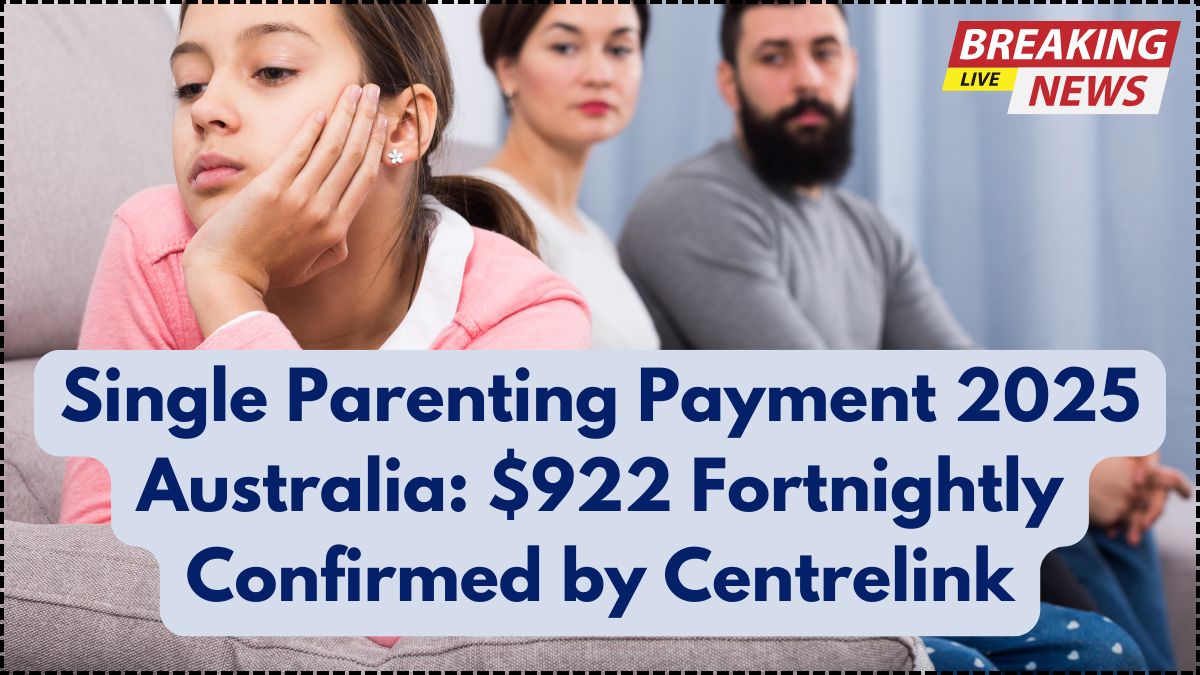The Single Parenting Payment Australia 2025 is a federal support initiative designed for eligible single parents facing financial challenges while raising children. As of July 2025, Centrelink has confirmed that eligible recipients can receive up to $922 every two weeks. This payment plays a critical role in reducing financial stress for solo caregivers and is a cornerstone of Australia’s broader social security system.

Updated Payout Amount Confirmed by Centrelink
As per the latest update from Centrelink, the current fortnightly payment of $922 reflects an adjustment based on inflation and cost-of-living changes. The aim is to ensure that single parents can afford essential living expenses, such as rent, food, schooling, and medical needs. This payout amount is reviewed periodically to stay aligned with national economic indicators and community needs.
Who Is Eligible for the Single Parenting Payment?
To qualify for the Single Parenting Payment Australia 2025, applicants must meet several criteria:
- Be the main carer of at least one child under 14 years old
- Be an Australian resident living in the country
- Satisfy income and asset tests set by Centrelink
- Not be in a relationship or defacto partnership
Applicants must update their details regularly to remain eligible. Centrelink may suspend or stop the payment if circumstances change and are not reported.
Key Features of the 2025 Payment Structure
Centrelink has streamlined the process for assessing and disbursing the payment. Here’s a snapshot of the current payment structure:
| Category | Details |
|---|---|
| Maximum Fortnightly Amount | $922 AUD |
| Eligibility Age of Youngest Child | Under 14 years old |
| Residency Requirement | Must reside in Australia |
| Income Threshold (Single Parent) | $2,332/month (approx.) |
| Asset Threshold (Homeowner) | $301,750 AUD |
| Review Frequency | Every 12 months or as needed |
This structure is intended to support a fair and transparent process while giving recipients a clear understanding of their entitlements.
How to Apply and What Documents Are Required
Single parents can apply online through their MyGov account linked to Centrelink. Paper-based applications are also available but may take longer to process. Key documents include:
- Birth certificate(s) of child(ren)
- Proof of Australian residency
- Tax and income details
- Proof of rental or mortgage commitments
Applicants should ensure that all submitted documents are up-to-date and accurate to avoid delays in approval.
The Broader Impact on Single-Parent Families
Receiving the Single Parenting Payment Australia 2025 is more than just financial relief. It directly supports a better quality of life, enables access to education and healthcare, and helps single parents focus on employment opportunities without compromising their family’s wellbeing. Centrelink’s continued commitment to adjusting the payout amount reflects an understanding of the changing economic pressures many families face.
Conclusion
The confirmation of the $922 fortnightly Single Parenting Payment Australia 2025 by Centrelink marks a significant financial safety net for eligible single parents. With the updated structure, flexible application process, and ongoing government support, this initiative is tailored to help single-parent households navigate financial challenges with dignity and stability.
FAQs
Who can apply for the Single Parenting Payment Australia 2025?
Single parents who are the main carers of at least one child under 14 years and meet Centrelink’s residency, income, and asset criteria.
How much is the Centrelink payment amount in July 2025?
As of July 2025, the confirmed payout amount is $922 per fortnight for eligible single parents.
What happens if my income increases?
Centrelink may adjust or stop your payment if your income goes above the allowed threshold. It’s essential to report any changes promptly.
Can I receive the payment if I am working?
Yes, as long as your income stays within the permissible limit, you can receive partial or full payments.
Is there a waiting period for new applicants?
In most cases, yes. The waiting period depends on your financial situation, including liquid assets and recent income history. Centrelink provides a specific estimate during the application process.
Click here to know more.